#álvaro domingues
Explore tagged Tumblr posts
Text

Paisagem Portuguesa. Duarte Belo e Álvaro Domingues [Fundação Francisco Manuel dos Santos, 2022]
#duarte belo#álvaro domingues#geografía#paisaje#territorio#fotografía#arch tekton#portugal#mar#2020s
9 notes
·
View notes
Text




Álvaro Domingues, Volta a Portugal, 2017
3 notes
·
View notes
Text
A diminuição dos gastos públicos entrou no centro do debate político e econômico nos últimos dias. O ministro da Fazenda, Fernando Haddad, já anunciou a necessidade de cortes nas despesas obrigatórias para o cumprimento da Lei do Arcabouço Fiscal, mas não especificou as áreas que serão atingidas Segundo o ministro, as medidas de contingenciamento e bloqueio serão divulgadas no dia 22 de julho, mesmo dia da publicação do Relatório Bimestral de Receitas e Despesas, elaborado pela Receita Federal. Até lá, a discussão sobre as áreas em que devem ocorrer os cortes tende a se intensificar. A Previdência Social costuma ser uma das áreas mais visadas. No entanto, a ideia de desvincular o piso previdenciário do salário mínimo é criticada pelo advogado e contador Álvaro Sólon de França, ex-secretário executivo do Ministério da Previdência e ex-presidente do Conselho Executivo da Associação Nacional dos Auditores Fiscais da Receita Federal do Brasil (Anfip). Para ele, o governo deveria reverter a desoneração de imposto em vez de pensar em diminuir valor de benefícios. “A desvinculação do salário mínimo dos benefícios previdenciários e assistenciais é um ajuste fiscal em cima da classe mais pobre. Vamos aumentar a pobreza e a desigualdade social no Brasil.” França, que prepara seu terceiro livro sobre a Previdência Social, disse à Agência Brasil que os benefícios previdenciários e assistenciais não vão para a poupança, nem para aplicação no mercado financeiro. "Eles vão diretamente para o consumo e a circulação do dinheiro que provoca a melhoria da qualidade de vida.” O especialista assinala que, na média, cada beneficiário recebe R$ 1.744 e que oito de cada dez benefícios pagos pela Previdência Social tem o valor de um salário mínimo. Assim, a desvinculação do mínimo teria efeito recessivo e ainda poderia diminuir a arrecadação de tributos em cima do consumo desses beneficiários – o que geraria desequilíbrio fiscal. Outro efeito seria o impacto nas contas de 4.101 municípios – 73% das 5.568 cidades brasileiras, nas quais os recursos oriundos da Previdência Social têm volume maior do que os repasses do Tesouro Nacional ao Fundo de Participação dos Municípios. Proposta de emenda Artigo de economistas ligados à Universidade Federal de Minas Geraus, publicado em março na revista Pesquisa e Planejamento Econômico, editada pelo Instituto de Pesquisa Econômica Aplicada (Ipea), também alerta para os possíveis efeitos sociais do corte de benefícios. O texto analisa a versão original da Proposta de Emenda à Constituição (PEC) 6/2019 que, à época, estabelecia o pagamento do benefício de prestação continuada (BPC) a partir dos 60 anos, mas com valor de R$ 400. O valor de um salário mínimo (então R$ 998) somente seria pago aos 70 anos, cinco anos depois da idade, como permanece em vigor. Os autores – Débora Cardoso, Edson Paulo Domingues, Luís Eduardo Afonso e Guilherme Cardoso – concluem que o corte de pagamentos do BPC proposto na proposta “seria bastante regressivo, impactando fortemente as famílias de menor renda.” Quanto a pensões e aposentadorias do Regime Geral de Previdência Social, eventuais cortes podem ser “positivos, ou menos negativos”, a depender do destino do dinheiro poupado, se, por exemplo, se adota uma suposição de resposta mais forte do investimento. O artigo defende, no entanto, que eventuais cortes em benefícios de servidores ativos e aposentados inscritos em regimes próprios de previdência social teriam “caráter progressivo” e diminuiriam a desigualdade. Divergência O Projeto de Lei de Diretrizes Orçamentárias (PLDO) de 2025, em tramitação no Congresso Nacional, prevê que o Regime Geral de Previdência Social terá arrecadação de R$ 709,1 bilhões, e o pagamento de benefícios previdenciários será de R$ 980,9 bilhões. Um déficit de R$ 271,8 bilhões, que impacta no resultado primário das contas públicas. De acordo com estimativa do PLDO, o salário mínimo passará dos atuais R$ 1.412 para R$ 1.502. Os R$ 90 de diferença
trarão impacto de R$ 51,2 bilhões, cerca de um quinto do déficit previdenciário, conforme nota técnica das consultorias de Orçamento da Câmara dos Deputados e do Senado Federal. Na avaliação do pesquisador associado do Instituto Brasileiro de Economia, unidade da Fundação Getulio Vargas (Ibre/FGV) Bráulio Borges, também economista sênior da área de macroeconomia da LCA Consultores, a Previdência Social é “a principal rubrica que deve ser ‘atacada’ para restaurar o equilíbrio fiscal brasileiro.” Em artigo recente, o economista opina que “um elemento crucial” para conter a expansão do déficit previdenciário seria desvincular o piso previdenciário, o BPC e outros benefícios assistenciais do salário mínimo nacional. “O salário mínimo é uma variável que deve, sim, ser reajustada ao longo do tempo em termos reais, refletindo ganhos de produtividade da mão de obra, mas é uma variável que deve regular o mercado de trabalho, ou seja, a vida de quem está participando ativamente da produção econômica. As aposentadorias e pensões deveriam ser reajustadas apenas pela inflação, mantendo o poder de compra ao longo do tempo”, afirma Borges. No texto, o especialista ainda defende o incremento da arrecadação com a futura cobrança do futuro Imposto Seletivo sobre produtos que impactam a saúde e o meio ambiente, e pondera que “alguns subsídios explícitos para o setor agropecuário (como equalização de juros do Plano Safra, dentre outros) poderiam ser reduzidos, uma vez que o setor já é altamente competitivo com “as próprias pernas”. Com informações da Agência Brasil
0 notes
Text
FEATURE
Dinis Santos, Um País Imaginário


Dinis Santos , Um País Imaginário, Pierrot le Fou.
Um País Imaginário [An Imaginary Country] focuses on contemporary vernacular architecture, bridging a gap between tradition and a fresh narrative. Starting with an uncommitted approach, the series evolved to align with established Portuguese photographic traditions. Covering the years 2017 to 2023, Santos pays homage to historical surveys, from the 1881 Scientific Expedition to Serra da Estrela to Álvaro Domingues‘ modern documentation of transgenic landscapes. Departing from a strict scientific perspective, Santos opts for an enchanting exploration of the imaginary present within the Portuguese territory.
The project delves into the symbolic concept of «home,» reflecting on Portuguese identity, local connections, and the socio-cultural impacts of emigration and economic shifts. The book features photographs primarily taken during Santos‘ journeys to villages marked by high emigration rates in Aveiro, Viana do Castelo, and Viseu. In Um País Imaginário, Santos captures landscapes, unveils technological contradictions, and interprets territory as a dynamic human «geology,» exploring the photogenic dimensions of products from the extractive economy, while providing a comprehensive view of Portugal’s changing cultural and economic landscape.

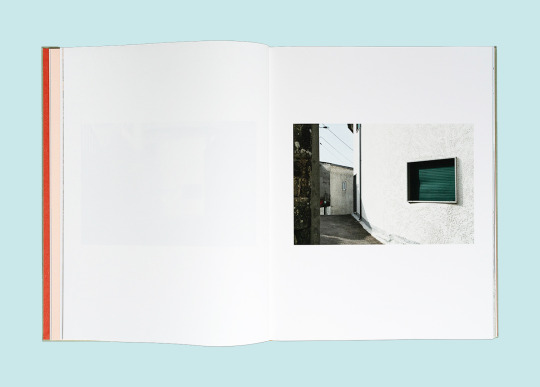
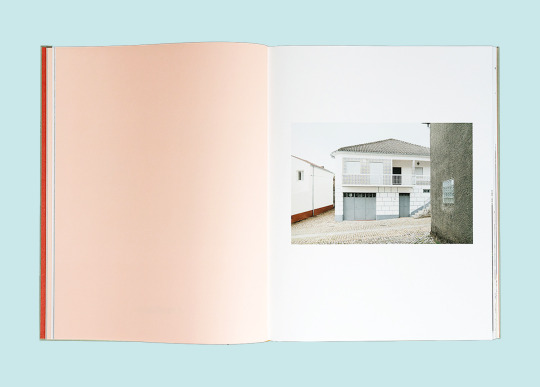

UM PAÍS IMAGINÁRIO 176 pages 24x31 cm Edition of 500 Pierrot le Fou
More info on → pierrotlefou.pt
#allcitiesarebeautiful#porto#portugal#vernacular architecture#new topographics#photo book#humanalteredlandscape#photographicresearch#alteredlandscape#builtenvironment
1 note
·
View note
Text
“A área de SST sempre foi meu foco. Meu começo serviu de base para que eu chegasse onde estou.”
Foi meu pai quem me despertou o interesse pela área de Saúde e Segurança do Trabalho. Ele trabalhava em atividades marítimas e, enquanto embarcado, tinha contato com técnicos de SST. Muito inspirado no que via no dia a dia, me apresentou possibilidades que determinaram meu futuro profissional. Meu nome é Álvaro Domingues. Eu ainda estava no Ensino Médio quando ele me sugeriu escolher entre a…

View On WordPress
0 notes
Text
Tribunál Aplika Prizaun Preventiva Bá Sidadaun Indonézia Ne’ebé Atu Vota Iha Darulete
Hatutan.com, (24 Maiu 2023), Díli—Tribunál Judisiál Primeira Instánsia Díli (TJPID), liuhosi Juiz Álvaro Maria Freitas, iha kuarta 24 maiu tuku 11:30 dadeer Otl, hasai ona despaixu ikus, hodi aplika medida koasaun Prizaun Preventiva bá arguidu ho inisiál VAG hosi Repúblika Indonézia, maibé tenta atu vota iha sentru votasaun EBF Darulete, Postu Administrativu Liquiça-Vila, Domingu…

View On WordPress
0 notes
Link
A partir desta semana, todas as quartas de abril, apresentamos LiterAto, série de curtas-metragens baseados na obra dos heterônimos do poeta português Fernando Pessoa. . A vasta obra de Pessoa é dividida entre os textos e poemas que ���ele mesmo” assinou - a sua obra ortônima - e as de seus heterônimos, Álvaro de Campos, Alberto Caeiro e Ricardo Reis, além do semi-heterônimo e menos conhecido autor, Bernardo Soares. . A questão desses heterônimos é resultado das características da própria personalidade de Pessoa. Esse desdobramento do “eu”, a multiplicidade de identidades e a sinceridade do fingimento, são condições que marcaram sua genial criação literária, considerada uma das maiores obras universais escritas em língua portuguesa. . A obra de Pessoa foi escolhida por estar em domínio público e ter caráter atemporal e universal. Já a escolha dos textos foi pela possível relação entre cada um deles e as fases deste período de pandemia: pessimismo (Campos), melancolia (Soares) e aceitação (Caeiro)” . Nesta quarta, 07, apresentamos “Tabacaria” e na próxima, 14, “Lisbon Revisited (1923)”, ambos poemas de Álvaro de Campos. No dia 21, apresentamos dois trechos, em um filme só, do “Livro do Desassossego”, de Bernardo Soares. E encerramos com o canto V de “O Guardador de Rebanhos”, de Alberto Caeiro. . A exibição é sempre às 19h30, pelo canal do YouTube do Edith Cultura. . Demais informações, fotos e links estão no site www.shelalmeida.com.br, que agora tá com a cara do LiterAto. (Link na bio) . O projeto tem idealização de Shel Almeida, direção de Marina Abib, atuação de Jeison Domingues, produção audiovisual de Rafael Silva, assistência audiovisual de Ana Arantes e produção executiva de Vera Abib. As artes e os site foram gentilmente feitos pela Laura A. Chaile. . Foi contemplado em edital referente à Lei de Emergência Cultural Aldir Blanc, promovido pela Prefeitura de Bragança Paulista, por meio da Secretaria Municipal de Cultura e Turismo, com apoio do Conselho Municipal de Política Cultural.
Mais informações: shelameida.com.br
#LiterAto#FernandoPessoa#álvaro de campos#fernando pessa#alberto caeiro#poesia#literatura#bernardo soares#tabacaria#london revisited#o guardador de rebanhos#livro do desassossego
34 notes
·
View notes
Text
The two servants that are “guarding” King João I of Portugal and his family in Batalha Monastery

The Monastery was founded by D. João I (1385-1433), in 1386, in thanks to the Virgin for the victory in the Battle of Aljubarrota (1385). Attributed to the Dominican Order, it assumed itself as a symbol of Portuguese independence legitimizing the Avis dynasty, ending the crisis of succession to the throne triggered by the death of King Fernando (1383) and the integration of Portugal in the Castile domain. The project, of unusual size in medieval Portuguese architecture, and by Afonso Domingues (1386-1402). After his death, Huguet (1402-1438) and Martim Vasques (1438-1448) succeeded him.
It has the first Royal Panteon where King João order so his royal family and descendants could rest after their death. BUT just before we enter the Founders Chapel we can see a 2 tombs at entrance of the Chapel, like guarding the Royal Family. Those two tombs belong to two men who served King João and his family, to the point of saving the King himself life during a battle.
Let’s found out:
1º Tomb: Martin Gonçalves da Maçada:

During the battle King João was attacked by a Castilian named Álvaro Gonçalves de Sandoval to the point that the King fell on his knees. Seeing the new King of Portugal with no weapon and on the floor, Álvaro was about to give the final blow and kill the Portuguese King. Seeing that his King was about to get killed, Martim Gonçalves came from behind and kills Sandoval with his weapon, saving King João life.


2ª Tomb: Diogo Gonçalves Travassos:

Diogo was King João I knight while he was King and tutor of one of his sons Prince Pedro and later an adviser to King João I grandson, King Afonso V. Diogo was always faithful to King João I, participating the Ceuta Conquer. He never left the royal family and because of that he died alongside his Prince: Pedro in the Alfarrobeira Battle where Prince Pedro also died.
Just like Martim, his remains are buried side by side with Martim, near the entrance of the Founders Chapel.

Because of that heroic act of Martim Gonçalves and as a gratitude for years of loyalty of Diogo Gonçalves, their remains are inside the Batalha Monastery, at the entrance of the Founders Chapel, guarding their King and his family even after death.
So to everyone who visit Batalha Monastery, before enters the Founders Chapel, look to your right and look at the tombs of these two men.
8 notes
·
View notes
Video
vimeo
SINOPSE / SYNOPSIS Quando alguém nos deixa, quando nosso teto desaba, quando nossas crenças parecem não fazer mais sentido, o que nos resta?
When someone leaves us, when our roof falls, when our beliefs seem to make no more sense, what remains?
FICHA TÉCNICA Ficção / 2K / 17 minutos 2017
Elenco: Carlos Eduardo Ferraz Rafael Cavalcanti Cintia Lima Paulo Cesar Freire Carmen Lucia Flora Negri Lucas Ávila Ruan Renato Marcelo Trindade Glauber Joaquim
Direção: Leon Sampaio e Fernando Lins (Yuri Lins) Ass. de Direção: Sâmia Emerenciano Roteiro: Leon Sampaio e Fernando Lins (Yuri Lins) Colaboradores de Roteiro: Álvaro Renan Brito e Luana Varejão Produção Executiva: Karuna de Paula Produção: Karuna de Paula, Marcela Lins e Luana Varejão Produção Local: Marcelo Trindade Assistentes de Produção: Juliana Soares e Pethrus Tiburcio Direção de Fotografia: Wallace Nogueira Assistente de Fotografia: Rafael Cabral Som: Nicolas Hallet, Lucas Caminha e Catharine Pimentel Direção de Arte: Letícia Barros Assistente de Arte: Rose Lima Gaffer e Elétrica: Carlinhos Tareco e Aranha Platô: Anderson Villar Montagem: Leon Sampaio e Fernando Lins (Yuri Lins) Edição de Som e Mixagem: Nicolau Domingues Correção de Cor e Finalização: Adriano Oliveira Tradução: Pedro Queiroz Arte gráfica: A Firma
1 note
·
View note
Text
Agriculture and Architecture: Saving Spaceship Earth
Sonja Dragović takes a closer look at the topics raised and conversations inspired by the exhibition Agriculture and Architecture: Taking the Country’s Side at the Lisbon Architecture Trienniale.
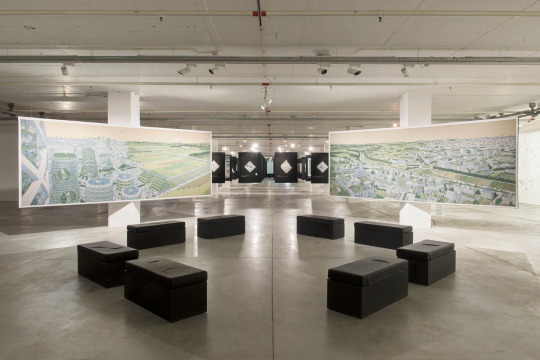
Agriculture and Architecture: Taking the Country’s Side exhibition is on display at the Garagem SulI until February 16. | Photo via Lisbon Architecture Triennale
The fifth edition of the Lisbon Architecture Triennale, entitled The Poetics of Reason and curated by the team led by architect and theorist Éric Lapierre, was opened in October 2019. Aimed at approaching, examining and presenting architectural rationality today from different vantage point, the program offered five main exhibitions: Economy of Means, curated by Lapierre himself, Agriculture and Architecture: Taking the Country’s Side, curated by philosopher and historian Sébastien Marot, Natural Beauty by Laurent Esmilaire and Tristan Chadney, What is Ornament? by Ambra Fabi and Giovanni Piovene and Inner Space by Mariabruna Fabrizi and Fosco Lucarelli. Related events – workshops, lectures, discussions – have been organized throughout the last fall, culminating with the end-of-November Talk, Talk, Talk: a three-day conference that brought academics, architects, designers and activists together for a weekend of lively conversation at the Calouste Gulbenkian Foundation.
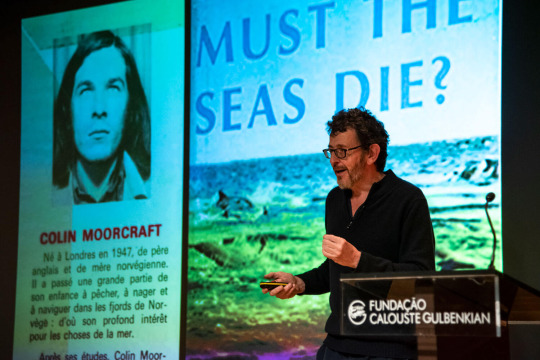
Talk, Talk, Talk: Sébastien Marot, curator of the exhibition. | Photo via Lisbon Architecture Triennale
The first day of talks was devoted to the topics raised by the exhibition Agriculture and Architecture: Taking the Country’s Side, the only one from the Triennale’s program still on display (at the Garagem SulI, until February 16). The exhibition strives to be practical, to find answers to contemporary climate change challenges by reconnecting and reconciling agriculture and architecture and harnessing the knowledge resulting from this reunion. The questions emerging from such goal – about the realities of industrial development, the future of metropolis, the complexities of food production, the ethics of design – were some of those unpacked and discussed at the Talk, Talk, Talk conference by the exhibition curator Sébastien Marot, environmental designer and ecological educator David Holmgren, architects and writers Carolyn Steel and Colin Moorcraft, philosopher Joëlle Zask and their eager audience.
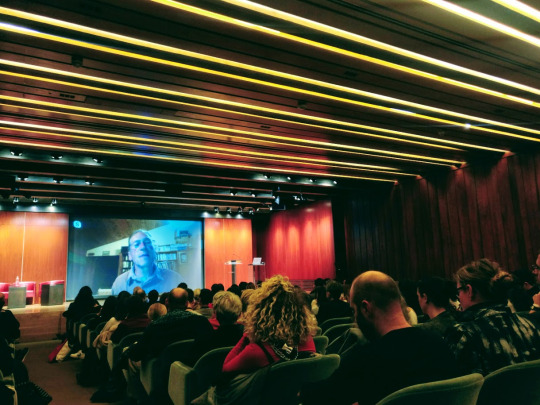
David Holmgren, one of the founders of the permaculture concept, joined the conference via Skype. | Photo by Sonja Dragović
David Holmgren joined the conference from Australia, just before the dawn; via Skype, we witnessed the sun rising on the other side of Earth as the evening conference in Lisbon was coming to a close. Best known as the co-founder of the permaculture concept, he described the way in which this idea that took shape in the mid-1970s at the University of Tasmania and at Mount Wellington, “at the sharp edge between the civilization and wilderness”, gained ground around the world and made it possible to imagine “climate chaos resistant design” on a global scale. Holmgren’s thinking and practice were inspired by indigenous practices in land use and agriculture, which understood and utilized ecosystems’ natural resilience and evolution. He emphasized the importance of dealing with the environmental crisis in large cities by upholding the practical thread of action and criticized the apathetic acceptance of the inevitability of status quo. For anyone interested in learning more about permaculture, his works Permaculture: Principles and Pathways Beyond Sustainability (2002) and RetroSuburbia: The Downshifter’s Guide to a Resilient Future (2018) will be a great start.
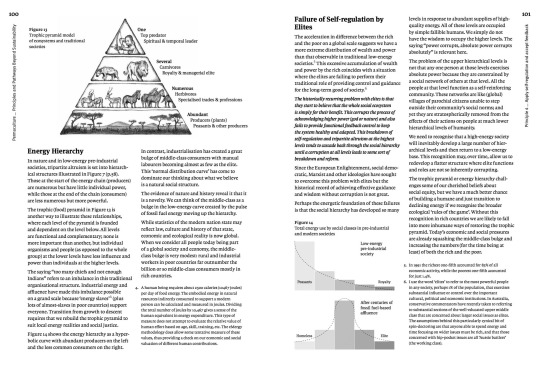
From Holmgren’s book on permaculture. | Excerpt via Holmgren Design
Carolyn Steel, British architect, author of Hungry City: How Food Shapes Our Lives (2008) and leading thinker on food and cities, pointed out the “urban paradox” of people living in urban areas, thinking of themselves as urban – detached from the countryside, but still depending on land and not grasping the true value of food. According to her, evolving technologies of feeding ourselves might make it appear that the food is simple – too simple to worry about in our digital age. However, the fact that the complexity is obscured doesn’t mean it isn’t there. Steel calls the world shaped by the current food systems Sitopia (from Greek sitos, food and topos, place). She advocates for changing the ways in which we perceive food supply and for becoming more self-reliant and community-oriented in food production and consumption: “To build a better society, we have to embrace this complexity.” Steel’s recently written for Architectuul on the topic of shaping our future through food.

Forthcoming book by Carolyn Steel. | Photo via Amazon.com
Steel’s argument that food production should be brought closer to home was affirmed by Colin Moorcraft, British architect and writer on environmental affairs, author of Designing for Survival (Architectural Design, 1972). He reminded the audience of the work of R. Buckminster Fuller, an architect and inventor who in 1969, just after the world has for the first time ever seen the photograph of Earth from space, had published an Operational Manual for Spaceship Earth. In it, Fuller wrote: “We are all astronauts and ours is a vehicle that requires maintenance, and that will cease to function if it’s not kept in good order.” He was one of the pioneers shaping the new global awareness, making it clear that we’re all in this together; the other key figures in this movement were, according to Moorcraft, scientists Ludwig von Bertalanffly, Howard Odum and Eugene Odum and the economist Nicholas Georgescu-Roegen.
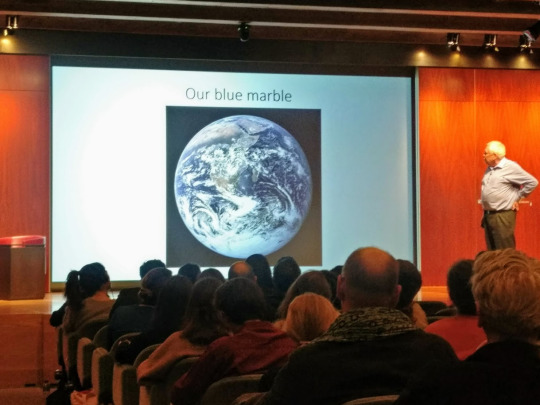
Colin Moorcraft at Talk, Talk, Talk: Apollo 8′s greatest legacy - a single photograph of home. Sent to examine the Moon, humans instead discovered Earth. | Photo by Sonja Dragović
They contributed towards understanding and defining the interdependence between ecosystems, Earth’s resources and humans. In the beginning of 1970s, they have warned the humanity against the extensive use of fossil fuels and mineral resources – these warnings were outlined in Moorcraft’s Designing for Survival in 1972. As we all know, we didn’t listen, and our environment – inseparable, of course, from our communities – suffers the consequences. What we must do to mitigate these effects and improve our situation, Moorcraft advises, is bring the countryside into the city and design for agriculture to become an integral part of urban experience: “Architecture-and-agriculture is of central importance for improving the prospects of future generations of Spaceship passengers”, he concludes.
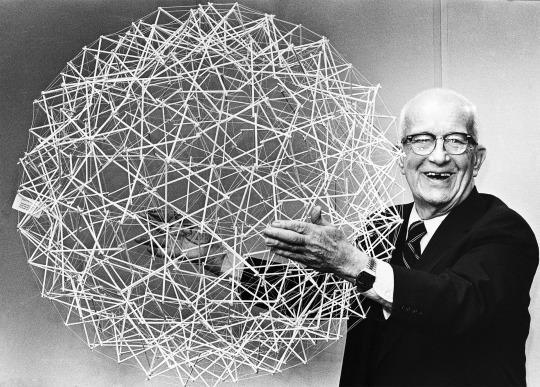
Buckminster Fuller: Making the world’s available resources serve one hundred percent of an exploding population can only be accomplished by a boldly accelerated design revolution. | Quote and photo via pbs.org
The final talk of the evening was given by Joëlle Zask, French philosopher, author of La Démocratie aux champs (2016). She introduced the origins of democracy as “peasant affair”, starting in the fields rather than in cities. When the separation of food production from intellectual labor occurred, taking care of the body (the countryside) was separated from taking care of the soul (the city); the body was deemed less important. This separation persists, and Zask argues that repairing the link between architecture and agriculture is important because it would mean rediscovering and repairing this connection, entering the discussion with the soil, cultivating relationship with the nature, and developing oneself. Finally, it would lead to a more democratic society.
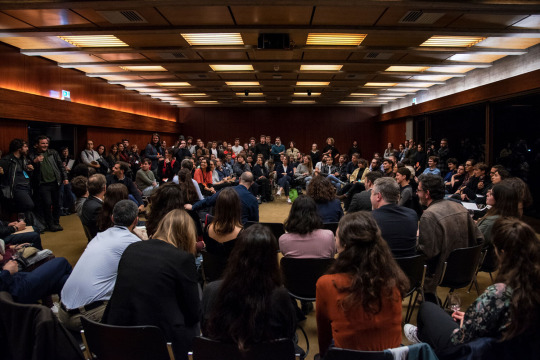
Talks after the talks: discussion with the audience at Calouste Gulbenkian Foundation. | Photo via Lisbon Architecture Triennale
Presentations by these four speakers, building upon topics outlined in the Agriculture and Architecture: Taking the Country’s Side exhibition, inspired an evening of lively discussion that spilled over into the next two days of the Talk, Talk, Talk conference. Now, this practical and hopeful stance towards the worrisome state of our environment should spill over into a bolder future action countering climate change. Our Spaceship needs repairs – and repairing the relationship between agriculture and architecture could be a great new start.
---
You still have a chance to see the Agriculture and Architecture: Taking the Country’s Side exhibition! This Saturday (Jan 25) at 5pm a guided tour will be organized, led by the professor and geographer Álvaro Domingues. More details available here.
2 notes
·
View notes
Text
#2252
@worldwidepedrol #citações #jornalpublico #alvarodomingues
Divago muito de cabeça para baixo.
Álvaro Domingues, jornal Público
View On WordPress
0 notes
Text








Álvaro Domingues / Graça Castanheira, A Rua da Estrada, Portugal, 2012
1 note
·
View note
Text
Prefeitos de Santa Bárbara d'Oeste, SP
1842 - 1844: Distrito de Santa Bárbara 1844 - 1846: Distrito de Santa Bárbara do município de Constituição para Campinas 1846 - 1869: Distrito de Santa Bárbara voltou a pertencer ao município de Constituição 1869 - 1906 : Vila de Santa Bárbara 1846 - 1869: Desmembrada do Município de Constituição 1906 - 1944: Cidade de Santa Bárbara 1944: Município de Santa Bárbara tomou a denominação de Santa Bárbara d’Oeste
Companhia Paulista de Estradas de Ferro (1917-1971) Fepasa (1971-1998) Estação Santa Bárbara d'Oeste (1917-1998)
1889 - 1890: Francisco de Paula Martins (PRP) 1890 - 1892: João Frederico Rehder (PRP) 1892 - 1901: José Gabriel de Oliveira e Souza (PRP) 1902 - 1905: Joaquim Veríssimo de Oliveira (PRP) 1905 - 1906: Thomas Alonso Keese (PRP) 1907 - 1913: Peregrino de Oliveira Lino (PRP) 1914 - 1928: José Gabriel de Oliveira e Souza (PRP) 1929 - 1930: João Oliveira Lino (PRP) 1930: João Pedroso (PRP) 1931 - 1935: João Oliveira Lino (PRP) 1935 - 1936: João Ângelo Suzigan Sans (PRP) 1936: Zeno Domingues Maia (PRP) 1936 - 1944: Plácido Ribeiro Ferreira (PRP) 1945 - 1947: Benedito da Costa Machado (PDC) 1947: João Eduardo MacKnight (PSP) 1948 - 1951: Lourival João Kirche (PSP) 1952 - 1955: Américo Emílio Romi (PTB) 1955: Domingos Finamore (UDN) 1956 - 1959: Benedito Costa Machado (PTN) 1960 - 1963: Dirceu Dias Carneiro (PSP) 1964 - 1969: Ângelo Giubbina (ARENA) 1969 - 1971: Bráulio Pio (ARENA) 1971: Augusto Scomparim (ARENA) 1971 - 1973: Bráulio Pio (ARENA) 1973 - 1977: Walter Landucci (MDB) 1977 - 1983: Isaías Hermínio Romano (PDS) 1983 - 1988: José Maria de Araújo Júnior (PMDB) 1989 - 1992: Isaías Hermínio Romano (PFL) 1993 - 1996: José Maria de Araújo Júnior (PSDB) 1997 - 2000: José Adilson Basso (PRP) 2001 - 2004: Álvaro Alves Corrêa (PMDB) 2005 - 2008: José Maria de Araújo Júnior (PSDB) 2009 - 2012: Mário Celso Heins (PDT) 2012: Luís Vanderlei Larguesa (PT) 2012: Mário Celso Heins (PDT) 2012: Luís Vanderlei Larguesa (PT) 2013 - 2016: Denis Eduardo Andia (PV) 2017 - 2020: Denis Eduardo Andia (PV) 2021 - 2024: Rafael Piovezan (PV) 2025 - 2028: Rafael Piovezan (PL)
0 notes
Photo

@portopostdoc O Fórum do Real é um encontro internacional, integrado na programação geral do Porto/Post/Doc, que se propõe pensar e discutir o cinema contemporâneo e os temas que dele decorrem. Este ano, o fórum contará novamente com três painéis de oradores convidados que irão debater "Ideias para Adiar o Fim do Mundo", declinada em três grandes grandes temas: Terra, Comunidade e Liberdade. 👉 Painel 1: Terra 🔸 Moderação: Raquel Ribeiro, jornalista, escritora e professora 🗣 Com: Álvaro Domingues e Marta Rodriguez 👉 Painel 2: Comunidade 🔸 Moderação: Abel Coentrão, jornalista 🗣 Com: Laura Sobral e Rob Hopkins 👉 Painel 3: Liberdade 🔸 Moderação: Ricardo Alexandre, jornalista 🗣 Com: João Pina, Pedro Matos e Selma Uamusse 📌 O Fórum do Real acontecerá nos dias 23, 24 e 25 de novembro, na Casa Comum da Reitoria da Universidade do Porto. #portopostdoc #portopostdoc2021 #framingreality #asnossashistoriassaoreais #documentary #porto #cinema (em Casa Comum - Cultura U.Porto) https://www.instagram.com/p/CVqFY4csIXr/?utm_medium=tumblr
0 notes
Text
Stamattina ho anche sbagliato a scrivere la data in risposta a un messaggio... non era il 23 aprile ma il 24 aprile di 5 anni fa. La mia tesi di dottorato si intitola “Il lavoro delle città. Preindustriale e prospettive di ricomposizione del rapporto territoriale” e tratta dell’importanza di descrivere la geografia del lavoro per comprendere i processi di urbanizzazione contemporanei e in particolare le trasformazioni del territorio ex rurale. Il tema della deruralizzazione del territorio italiano ancora non siamo riusciti ad affrontarlo come si deve, soprattutto culturalmente, e ciò ci limita molto più di quanto pensiamo. Sono e sarò sempre tanto riconoscente a Álvaro Domingues per avermi detto una volta in macchina: “Ma tu non guardi mai fuori dal finestrino. Un architetto che non guarda fuori dal finestrino...che architetto è?”

#luoghicomuni#commonplaces#lugarescomuns#italia#italy#itália#cartolina#postcard#postal#paesaggio#landscape#paisagem#architettura#architecture#arquitectura#urbanistica#urbanism#urbanismo
0 notes